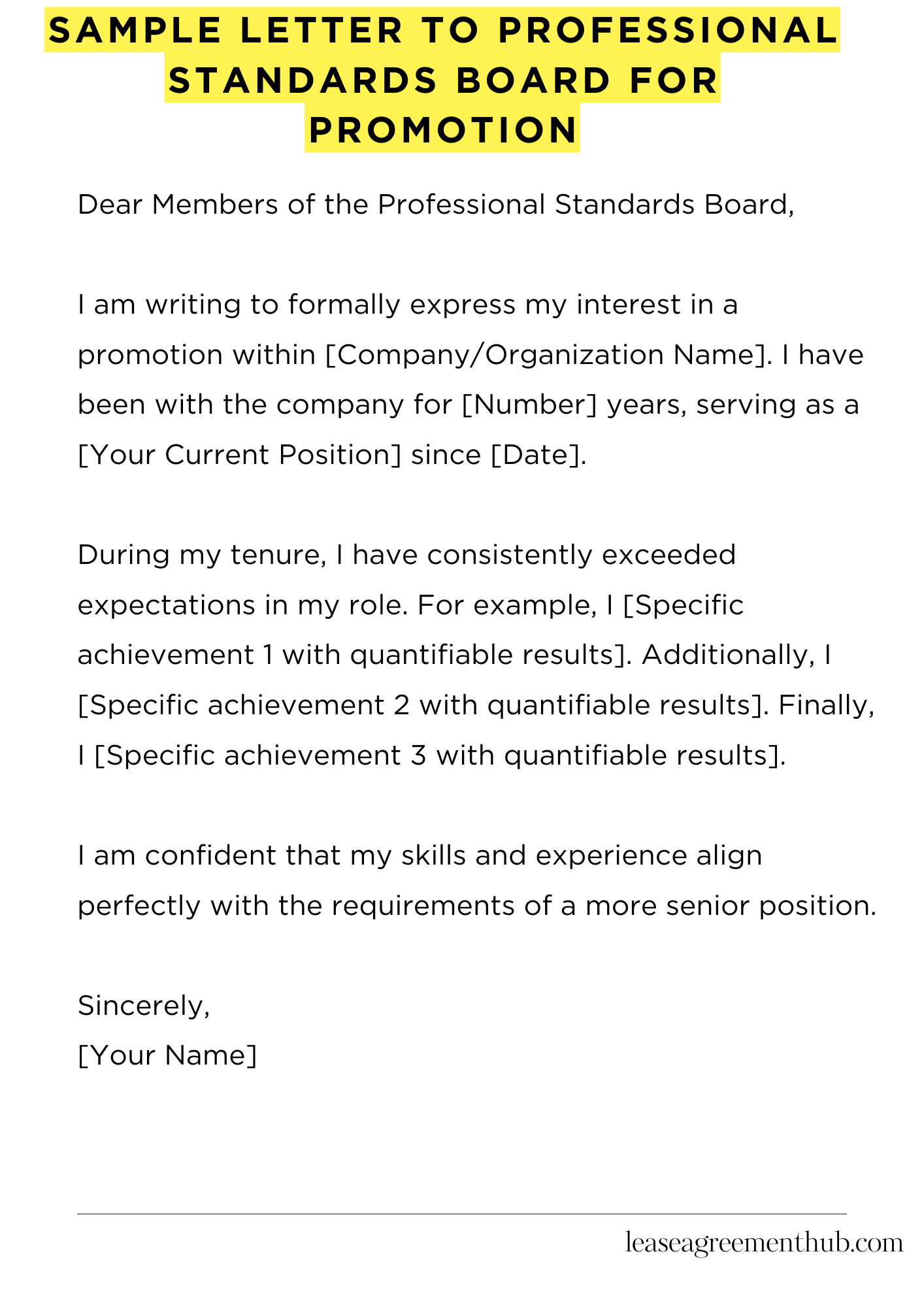A “Sample Letter To Professional Standards Board For Promotion” is a formal request. It asks for career advancement. Professionals often write it. They seek recognition for their skills and contributions.
Need to impress the board? Stuck on how to start? We’ve got you covered.
This article provides sample letters. Use them as templates. Tailor them to your situation. Make your promotion case strong.
Sample Letter To Professional Standards Board For Promotion
[Your Name]
[Your Address]
[Your Phone Number]
[Your Email Address]
[Date]
Professional Standards Board
[Board Address]
Subject: Application for Promotion – [Your Name]
Dear Members of the Professional Standards Board,
I am writing to formally express my interest in a promotion within [Company/Organization Name]. I have been with the company for [Number] years, serving as a [Your Current Position] since [Date].
During my tenure, I have consistently exceeded expectations in my role. For example, I [Specific achievement 1 with quantifiable results]. Additionally, I [Specific achievement 2 with quantifiable results]. Finally, I [Specific achievement 3 with quantifiable results].
I am confident that my skills and experience align perfectly with the requirements of a more senior position. I possess strong [Skill 1], [Skill 2], and [Skill 3] abilities, which I believe would be valuable assets to the team. I am also a dedicated and reliable employee with a proven track record of success.
I am eager to contribute to the continued growth and success of [Company/Organization Name] in a more significant capacity. Thank you for considering my application. I have attached my resume for your review and welcome the opportunity to discuss my qualifications further.
Sincerely,
[Your Name]

How to Write Letter To Professional Standards Board For Promotion
Subject Line: Clarity is Key
- The subject line is your letter’s herald. Make it concise and unambiguous.
- Instead of a generic “Promotion Application,” try: “Request for Promotion Review – [Your Name] – [Current Position].” This specificity ensures immediate attention.
- Avoid cryptic abbreviations; spell it out for maximum lucidity.
Salutation: Setting the Tone
- Address the board with due deference. “Dear Esteemed Members of the Professional Standards Board,” is always a safe bet.
- If you know the chairperson’s name, using it adds a personal touch but isn’t mandatory. If so, double-check the correct spelling!
- Steer clear of informal greetings. This is a formal entreaty, not a casual missive.
Introduction: Anchoring Your Claim
- Clearly state your purpose in the opening paragraph. Leave no room for ambiguity. Example: “I am writing to formally request consideration for promotion from [Current Position] to [Desired Position].”
- Briefly allude to your tenure and key accomplishments. This provides immediate context.
- Avoid excessive laudation. A measured tone conveys greater credibility.
Body Paragraph 1: Quantifiable Achievements
- Showcase your achievements with tangible evidence. Don’t just say you’re a “hard worker”; demonstrate the impact of your efforts.
- Use metrics and data to substantiate your claims. “Increased sales by 15% in Q3” is far more compelling than “Improved sales performance.”
- Focus on accomplishments that directly align with the requirements of the desired position. Strategically tailor your narrative.
Body Paragraph 2: Skill Augmentation and Training
- Highlight any new skills or training acquired since your last review. This demonstrates a commitment to professional development.
- Specify how these skills have been applied to enhance your performance and contribute to the organization’s objectives.
- Include relevant certifications, workshops, or advanced degrees. Emphasize continuous growth and adaptation.
Body Paragraph 3: Leadership and Mentorship
- If applicable, detail your leadership roles and mentorship activities. This showcases your ability to guide and inspire others.
- Provide examples of how you’ve fostered teamwork, resolved conflicts, or mentored junior colleagues.
- Quantify the impact of your leadership whenever possible (e.g., “Mentored three junior associates, all of whom achieved successful project completion”).
Closing: A Cordial Conclusion
- Reiterate your enthusiasm for the opportunity and your commitment to the organization.
- Express your gratitude for the board’s time and consideration.
- Use a formal closing such as “Sincerely” or “Respectfully,” followed by your typed name and signature.
- Proofread meticulously to expunge any errors. A polished presentation reflects professional acumen.
Frequently Asked Questions: Sample Letter to Professional Standards Board for Promotion
This section addresses common inquiries regarding the composition and submission of a sample letter to a Professional Standards Board in support of a promotion. Understanding these guidelines can significantly enhance the effectiveness of your letter.
What is the purpose of a sample letter to a Professional Standards Board for promotion?
The purpose is to provide the Board with a clear and compelling example of your writing ability, professional communication skills, and understanding of the standards required for the promotion you are seeking.
What key elements should be included in the sample letter?
The letter should demonstrate your knowledge of relevant professional standards, showcase your accomplishments, highlight your contributions to the field, and articulate your suitability for the higher position.
How formal should the tone of the letter be?
The tone should be highly formal, professional, and respectful. Avoid colloquialisms, slang, or overly familiar language.
What is the recommended length for the sample letter?
While there is no strict length requirement, the letter should be concise and focused, typically ranging from one to two pages. Prioritize quality and clarity over quantity.
Should the sample letter address a specific scenario or be a general statement?
The letter can either address a specific scenario relevant to the promotion or serve as a general statement of your qualifications and understanding of professional standards. The choice depends on the specific requirements of the Board.
Related: